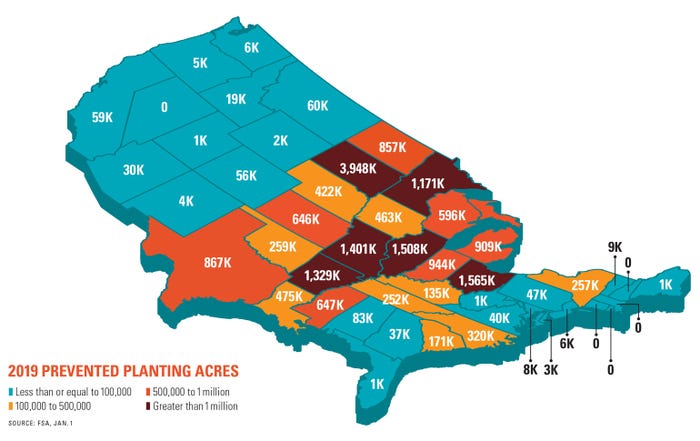
Helpless.
That’s how Illinois farmer Megan Dwyer felt after forty days of rain left her family farm’s Coal Valley, Ill., fields swamped last spring. Dwyer, who farms 700 acres of corn, soybeans and alfalfa with her father Richard, watched the calendar turn to June with only a handful of acres planted.
That scene played out for thousands of row crop farmers over most of the corn belt, leading to nearly 20 million acres of prevented planting acres. Now, nearly a year later, relentless storms have plagued most of the south and Midwest again, putting further pressure on farmers who desperately hoped to hit the reset button and get ‘back to normal.’
“I don’t know anyone who didn’t finish up in December if not January,” Dwyer says wearily. “It was just a year that would not end. We’re going into spring with river and soil saturation levels higher than last spring, so another wet spring will be problematic.”

Feeling distracted
Many farmers hoped for a big rally after last year’s crazy weather, but unlike the drought of 2012, these markets saw ‘rain makes grain.’ Then Black Swan events like Coronavirus amid trade wars added to the frustration and tanked markets even further.
Now, despite new trade deals, some farmers may be lulled into hoping for more government help instead of doing what they do best – planting and planning for profit.
“Farmers seem as distracted as I’ve seen in 15 years,” says Steve Johnson, Iowa State University farm management specialist. “There’s a lack of focus in the countryside. Most farmers are still hanging on to 2019 bushels and focused on last year’s wet corn and weather; they’re still focused on things out of their control, and it’s distracting them.”
Johnson believes farmers are pushing risk management decisions later in the winter, based on what he’s seen from slower signups for ARC/PLC and crop insurance. “That’s not going to bode well if you’re holding large amounts of unpriced bushels from the previous year, and it won’t bode well for making pre harvest sales either,��” he says.
“We’re going back to a pattern reminiscent of 2004-2006,” he observes. “We’re not making much money and we’re becoming more dependent on the federal government rather than the marketplace. Farmers are talking about how they have to have an MFP payment in 2020 to make a profit.”
To be sure, a core group of producers – maybe 20 to 30%, he estimates – have their eye on the ball, concentrating on lower costs, minimizing risk, and selling rallies. But the late 2019 planting season followed by late harvest and continued wet conditions has made a stressful time of year more difficult. Much of the U.S. is primed to suffer multi-billion dollar flood losses, with farmers already steeling themselves for another round of planting delays.

Be proactive
Rain or shine, how can you stay Zen in all the spring planting chaos?
First, put together a plan; work the plan; and then call an audible when it’s time to change the plan. Consider these useful tactics from Johnson:
Marketing
Don’t let planting cause you to miss opportunities. Develop a written marketing plan that will be executed between now and mid-November.
Understand futures price seasonals, which favor making spring sales
Calculating 2020 breakeven prices using APH yields
Anticipate more normal basis next fall, winter and spring where you typically deliver your cash bushels
Utilize revenue protection crop insurance and separate delivery from non-delivery bushels
Anticipate your farm’s cash flow needs next fall and winter
Avoid putting excessive unpriced bushels in commercial storage
“There are tools available to make potential sales during the busy spring season,” adds Purdue ag economist Mike Boehlje. “You can develop a plan with your broker or local elevator to set trigger prices, target dates, and put some orders in, so sales go through if you get your price even if you’re busy planting.”
Time Management
Lay out plans for each field and crop and calculate expenses and income. Have a backup plan for the inevitable weather disruption. “No matter how well we’ve laid out the plans for the coming year, something always changes,” says Missouri farmer Tom Waters. “Managing and adapting to unexpected changes is part of every farmer’s life. We constantly change our day-to-day activities based on what the weather will allow us to do.”
Ensure that your suppliers and support team know the plan down to the smallest detail. Make sure deliveries are in the right place at the right time. Get it as well organized as you can so there’s no downtime when weather turns on you. During planting season overcommunicating is expected.
Make sure the team is ready. “Everyone should be grounded in the expected workflow schedule and sequencing by field, in case someone needs to fill in for another,” notes Boehlje. “That not only helps you be more successful getting things accomplished, it’s a mental exercise that can help shake off the winter blues.”
Timeliness is everyone’s middle name. Think about work schedules and ensure equipment is prepped. With technology like fast-speed planting, autosteer and GPS, consider working the planter 18 to 24 hours a day if you have the crew. If you’re a one-man band, consider having some apps applied by the co-op or hiring the neighboring retired farmer to help. “If the conditions are right you can’t let darkness keep you from getting the work done,” says Boehlje. “Keeping the planter going is essential.”
Take time off. Really? Last summer we heard too many stories about farmers – young and old – going to the Emergency Room with chest pains and anxiety attacks as the wet spring kept them out of fields. Don’t let uncontrollable factors ruin your health, family life, or upbeat mindset. Use weather disruptions as an excuse to destress and have fun: take in a ballgame, open up a good book, or take someone to dinner.
Work through the 'what-if' list
How you deal with the unexpected can have dramatic impacts on your bottom line at the end of the year. Ask yourself these questions:
How do we handle major breakdowns during planting or harvest?
What do we do when a key employee becomes sick or is unable to work?
Can we react quickly when an infestation of pests attacks our crop?
Are we willing to seek extra help when we get behind?
Have a written plan to answer all these questions and share it with the team.
“If our combine catches fire we know where we can quickly get a replacement or can hire custom help to get us through the remainder of harvest,” says Waters. “Likewise, with other machinery we work with reliable dealerships that can provide timely service when needed or provide a replacement machine or implement for repairs requiring extended downtime. For minor repairs, we plan for breakdowns by having a supply of commonly used parts on hand to reduce downtime.”
Even so, it’s tough to keep calm when Mother Nature has other ideas.
“People forget all the work that goes into putting in a crop and how much faith you have to put into the weather,” Dwyer says. “It’s tough to put together a plan and have very little control of the outcome.”
About the Author(s)
You May Also Like






